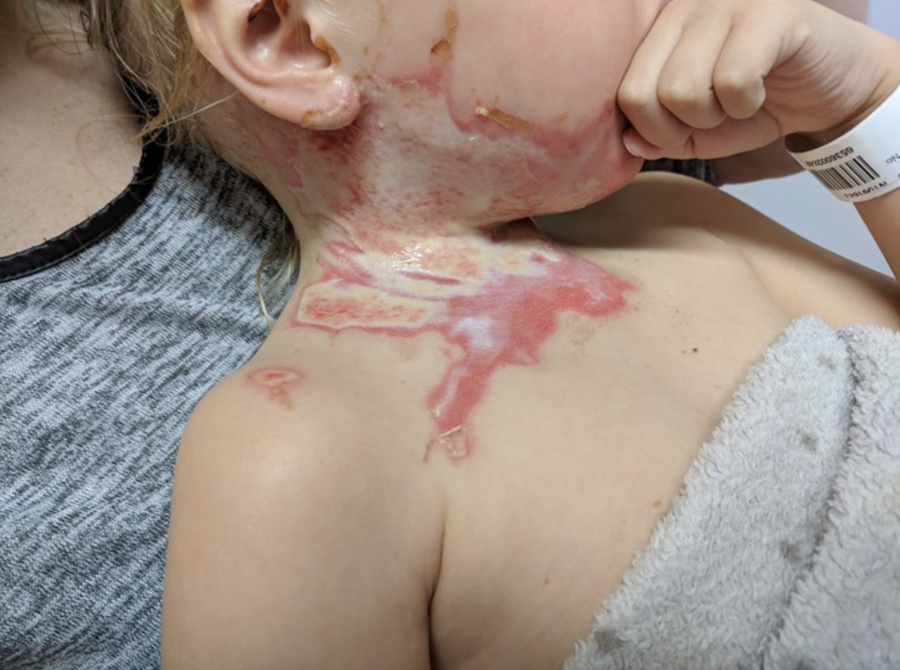Are you celebrating firework night at home this year? If so, make sure you read this blog first – it is predicted that this year 500 children and their families will join the growing number of people who will remember bonfire night for the wrong reasons . . .
Here are the facts:
- Over 550 children under 16 are taken to A&E in the 4 weeks surrounding Bonfire Night alone
- Most injuries happen at private or family displays
- The vast majority of firework burn injuries are to the eyes, head or hands, meaning children will have visible scars for life
- Rocket, air bomb and sparkler incidents are the most common
Real life story: Rosie-May

“In a flash ALL our lives were changed, the laughter and happiness of the children instantly became fear . . .”
4 year old Rosie-May was hit by a firework that went astray at a home display, on Bonfire Night in 2017. One of the multi-shot fireworks went the wrong way and hit poor Rosie-May in the neck, setting her coat on fire. She was rushed to a specialist burns unit, and had to endure 5 weeks in hospital. Her mum and dad are working with the Children’s Burns Trust to raise awareness so that no other family has to go through what they went through.
Ideally, attend an organised firework display, but if you decide to host your own, here’s how to stay safe:
- Only adults should set up, light and dispose of fireworks - children should not handle fireworks, tapers or matches. Have a chat with them before the display about why it is unsafe for them to touch or stand too close.
- Alcohol and fireworks do not mix. Discuss beforehand who will be in charge of your display.
- Only buy fireworks carrying the CE mark which means they have been safety checked.
- Make sure you have a torch handy for reading instructions.
- Keep naked flames, including cigarettes well away from fireworks.
- Make sure your audience is stood well back from the display - the firework instructions should tell you how far back people need to stand.
And what about sparkler safety?
- It is not recommended to give sparklers to under 5s - after all a sparkler can reach temperatures 20 times that of boiling water. Instead, stand back and show them the beautiful patterns you can make with your sparkler!
- Make sure everyone handling sparklers is wearing a pair of gloves.
- Hold sparklers at arm's length and a sensible distance away from others.
- Never hold a baby in your arms whilst holding a lit sparkler.
- Have a bucket of cold water to hand to put the finished sparkler in, hot end down – the metal stays super hot even once the sparkle has stopped.
We all know that even when taking precautions, accidents can happen. If anyone suffers a burn:
- As quickly as possible, cool the burn using running cool water for 20 minutes – this will feel very uncomfortable , especially for a child but is the best way to avoid long term burn damage.
- Remove any clothing and jewellery near the burn, unless it is melted or firmly stuck to the wound.
- Cover the wound with cling film or a sterile, non-fluffy dressing or cloth and make sure the patient is kept warm.
- Call 999 or 111 if necessary - for burns larger than a 50p coin, it is essential you call 999 or visit A&E.
We hope you have fun whatever you decide to do to celebrate Bonfire Night, but please do stay safe folks!
The Mini First Aid Team x
For more information on firework / sparkler safety see RoSPA and the Children’s Burns Trust
Be Bonfire Night ready with our Home and Away Bundle
Did you know both our Mini First Aid kit and our Family First Aid kit contain burn gel, and come with a handy QR code giving you direct access to videos that will teach you what to do in the event of a burn? You get both kits in our great value Home and Away Bundle - keep one in your car and one in the house.
Make sure you've got a first aid kit handy this Bonfire Night!








